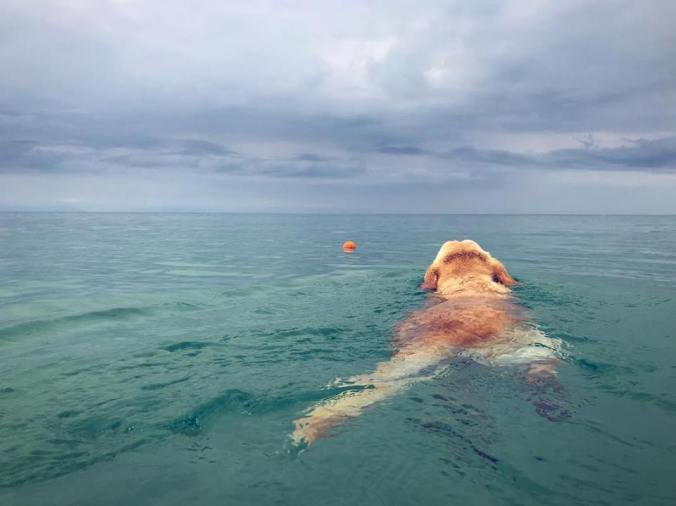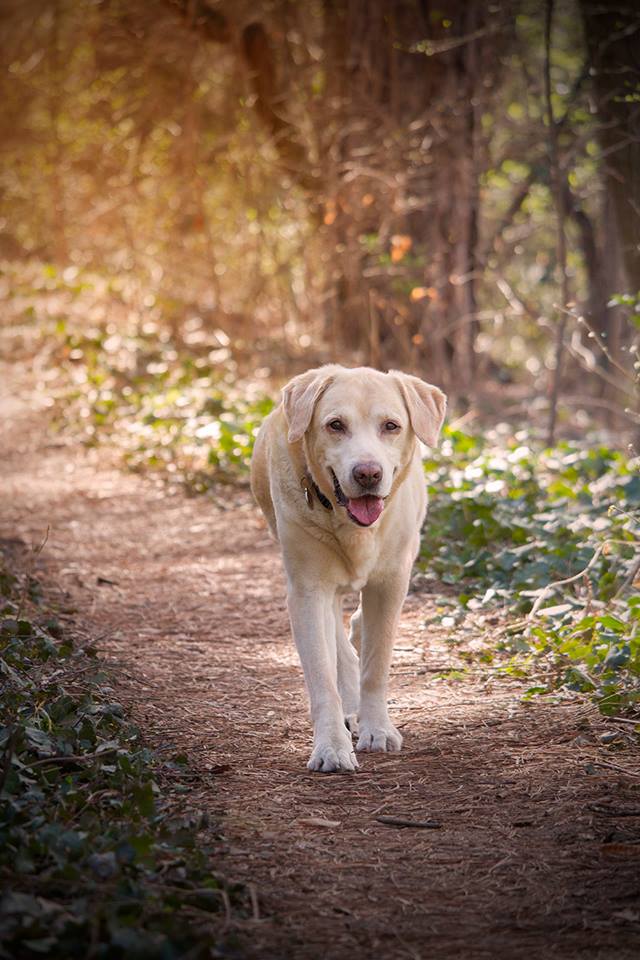It’s been a while since I started thinking about writing a post on dog arthritis and sharing my experience and knowledge on the topic, as well as putting it all in one place (easier to share with other people who may be going through the same issues with their pups and are looking for some input and advice).
First of all, a full disclaimer: I am NOT a vet. I am just a humble dog owner who spent a lot of time reading, trying, failing, and succeeding in managing my pup’s arthritis. Second, please keep in mind the following: arthritis cannot be healed, arthritis can only be managed. Don’t expect miraculous improvements. Be consistent. Arthritis is a constant roller-coaster, so be patient.
Okay, let’s start. About Cookie first – Cookie is a 13 year-young Labrador Retriever. Labs are notorious when it comes to joint issues, especially as they get older, but I can assure you that Cookie is on the top of the list named “Joint disaster”. When Cookie was 4 and 5 years old respectively, he tore both his cruciate ligaments in his knees. The first one eventually required surgery, beside all our efforts to manage conservatively (the surgery performed was extracapsular repair – when an implant is placed to stabilize the joint before scar-tissue develops); the second one did heal on its own. At age 8, when a dog accidentally fell on Cookie during play, we found out about spondylosis (arthritis in his spine) in the lumbar region. At age 9, Cookie was hit by a car. He suffered complete hip luxation and surgery called Femoral Head Osteoctomy (FHO) was performed. The recovery was not without complications: nerve injury, muscle atrophy, extra pressure on the other legs. At age 11, Cookie started limping badly on his left front leg, with almost no weight-bearing – x-rays showed end-stage arthritis in his elbow.
Is “joint-disaster” a good name for the list and did Cookie make it to the top 5?
First picture: left hip completely dislocated after car accident.
Second picture: FHO performed (you can see the blank space, i.e. no joint – the x-rays are not the best since Cookie was not sedated, but you get the picture).
The other hip is also showing signs of arthritis.
This is Coookie’s left elbow. Severe arthritic degeneration can be seen in both x-rays.
Okay, so this dog who started having joint issues since the young age of 4 and has suffered a severe trauma (hit by car) at age 9, must be crippled for life, his quality of life decreased beyond repair, and must have been put down by now to end his misery, right?
WRONG.
That dog has walked and swam for miles, hiked mountains, chased and retrieved toys and balls, wrestled with friends and has lived life to the fullest. Nowadays we still walk, hike, swim, and occasionally he is allowed to do a few fetches, since he loves fetching so much.
This is Cookie at a younger age. He was always a very active dog. Loved running.
And here he is now – all these pictures are recent – taken this year. First two depict Cookie’s happiness when running through the snow (he loves the snow!), the third one is us resting at the top of a hill during our most recent hike, and the last one depicts Cookie’s biggest love – the water.
Doesn’t look bad for a 13 year-old Labrador who just made it to the top of the “Joint disaster” list, right? What’s the catch?
Let me start on a positive note. There are two good things about arthritis:
- It’s not life-threatening (you die with it, but you won’t die from it)
- It’s manageable
As our dogs get older, age-related, chronic diseases start to develop. I won’t name them, but certainly some come to mind. If you had to choose one, which would you choose? I made my choice pretty easily: it’s definitely arthritis.
Dogs with arthritis can still get a good quality of life, and even thrive. Cookie is, I believe, a really good example of this. He still enjoys his walks and looks forward to them, although they did get slower and shorter over time. He enjoys swimming during the warmer months, and an occasional game of fetch. And he lives his days relatively pain-free.
I will write about the things we do on a daily basis and how we manage arthritic pain. I will also write what we do during flare-ups. And last but not least, I will write about the supplements that we have tried – I will make lists of those we still use, and I will write about those that didn’t work for us (which doesn’t mean they won’t work for you).
Again, full disclaimer, I am not a vet, and this is by no means an advertisement for any drug company (I don’t work in the business). The list is solely for the purpose of potentially helping other dogs and their owners battling arthritis.
- Regular Exercise
I’ve put it first for a reason. I believe it’s crucial for managing arthritis, especially on the long run. However, you should be careful not to overdo it, especially if your dog hasn’t been active for a while. Build-up gradually. Avoid being a weekend-warrior. With our busy work-day schedules, we are all guilty of being weekend-warriors sometimes. Make the walks shorter, but more frequent. Instead of doing one 2-hour long walk, do 4 walks that last 30 minutes each. For example, Cookie used to get an hour-and-a half-long walk when he was younger. When he started having issues, I’ve cut the walk in two – 45 minutes in the morning and 30 minutes in the afternoon, which we still do. He also gets three shorter walks during the day (15-20 minutes each).
Exercise should be low-impact for dogs with arthritis. A slow walk on the leash, swimming and walking in water are great for arthritic dogs. Avoid jumping, running for longer periods of time and abrupt stops (as in fetch). I did write above that I do let Cookie play fetch occasionally, but I have modified the game – I don’t allow him to run after the ball before the ball hits the ground. You can also play hide-and-seek with your dog. Hide the ball and let him search for it – this is great mental exercise too!
Bear in mind that over-exercising is as bad as not-exercising. Start with shorter walks and build up gradually. Not all dogs are the same, so I can’t give you a definitive answer how much you should exercise your dog. However, if you notice your dog being too sore after exercise, you probably overdid it.
Exercise restriction should also be applied in two cases: after surgeries and during flare-ups. I will write about flare-ups later on, but in these cases you should definitely follow your vet’s or surgeon’s advice.
Why exercise is important:
- For keeping and building-up muscle-tone (muscles help with stabilizing the arthritic joint – avoid muscle-atrophy at all costs. Muscles atrophy fast if not used, but it’s not easy to build them back up)
- For lubricating the joint and maintaining good range of motion
- Keeps your dog fit and without excess weight (if your dog is overweight, he should lose the extra pounds as soon as possible – they put unnecessary pressure on already suffering joints. Arthritic dogs should be kept at a normal-to-thin body shape)

Cookie swimming in the sea during a cloudy, but warm day in September, 2018.

Cookie loves walking in the woods. Here he is at the Bukulja mountain, November 2018.
2. Diet
A good diet is as important as regular exercise. The best way to feed your arthritic dog is to make your own food at home. Here’s why:
- Dogs with arthritis need a low-carb diet (carbs have been proven to increase inflammation – and arthritis is inflammation; commercial foods are loaded with carbs)
- Dogs with arthritis need a high, good-quality protein diet (proteins help build muscle tone – commercial pet foods use grains, potatoes and other low-quality protein as main-protein source. Good quality protein should come from animal sources.
- You decide what ingredients you put in your dog’s bowl. This way, you have better control over what your dog eats, and you can easily avoid any ingredient that doesn’t agree with your dog.
My dog has been raw-fed since 2013 (he was 6 1/2 at the time). I follow the BARF model, with 80% meat (80% muscle meat, 10% bone and 10% organs – I just recently stopped giving bones because, due to his age, he started having constipation issues) and 20% veggies and fruit. He gets a raw egg every other day (the best of the best where protein quality is concerned), and sometimes kefir and yogurt. Meat sources include: chicken, turkey, beef, lamb, and fish (sardines and salmon). No grains whatsoever. I did feed him rice when he was younger, especially during the summer months, when he was so active he couldn’t keep any weight on. Dogs use fat as energy source and cannot use carbs for this purpose – carbs have to be converted to fats first.
Examples of Cookie’s meals.
3. Supplements
I don’t believe arthritis can be managed without supplements, and this is where it can get too expensive, especially since one supplement only will not do the trick. Cookie is on a combo of supplements, and the list can be expanded with the supplements that we have tried (but didn’t work for us). I will mention the supplements that didn’t work for us, simply because that doesn’t mean they won’t work for you and your dog. Some people have had success with them too.
- Glucosamine & Chondroitine: an inseparable part of any arthritis management. There are a lot of brands out there. Some of them also add vitamin C, MSM, and other additional ingredients proven to alleviate arthritic pain. We currently use Chondro Super (by Canvit) and have used Flexadin (by Vetoquinol) with great success. Supplements that we have tried, but didn’t work for us are: YuMove (Lintbell’s) and Flexadin Advanced (Vetoquinol).
- Vitamin C: proven to decrease inflammation. Use buffered vitamin C. I use Ester C by Natural Wealth.
- Vitamin E: potent antioxidant. Scarce in food. Supplement especially if you give fish oil that doesn’t have vitamin E added. I use Natural Wealth’s vitamin E.
- Salmon (or fish) oil: rich in omega 3 essential oils. Proven to reduce inflammation. I use Brit Care’s Salmon oil.
- Turmeric (golden) paste: turmeric has been well-known for its anti-inflammatory properties (among other goodies it provides). There are plenty of videos and recipes on how to make your own golden-paste. Dogs love it and your dog will benefit from it in many aspects!
- Herbs: I add ginger and basil for additional vitamin C.
Keep in mind: arthritis is inflammation! Reducing inflammation equals less pain in the joint.
I’ve also tried beef-gelatin. Many vets and dog owners have recommended it to me, and many have had great success with it. I did try it with Cookie on many different occasions, but didn’t get the expected results, so I stopped it.
You can also add food rich in Glucosamine to your dogs meals: like chicken legs and beef trachea.
4. Additional Treatments (Physical Therapy)
Physical Therapy has helped Cookie tremendously, especially during acute pain (flare-ups). Our physical Therapy sessions included: Electrotherapy, Laser Treatments and treatment with Magnets.
Passive range of motion exercises are excellent because you can do them at home. They help maintain the range of motion in the arthritic joint.
Sit-stand up or lay-stand up exercises are great for dogs with back-end weakness. You can also do them at home.
Cookie during physical therapy sessions: (left to right) passive range of motion exercises, laser, electrotherapy + magnet (spine), electrotherapy (elbow)
Hydrotherapy – if you have facilities that offer hydrotherapy in your area (I am not that lucky) it’s the way to go! Hydrotherapy includes swimming and underwater treadmill. It helps maintain joint mobility and muscle strength without putting stress on the joints. Even though we are not the lucky ones since facilities that would offer this type of therapy are non-existent in my country, we improvise. During the warm months (from end of April to end of September) we swim in rivers, creeks, lakes, and the sea (we go to the seaside by the end of summer). The substitute for the underwater treadmill is a nearby fountain, which we frequent on a daily basis.
Cookie swimming in the fountain, the lake of Ada Ciganlija, the lake of Bešenovo and the Sava river
5. Heat and cold therapy
Applying a towel soaked in warm water is a routine after walks. Warmth helps in alleviating pain and is especially helpful during the cold winter months. Cold (ice) is usually applied during flare-ups when the joint is swollen (read on flare-ups). If you apply both warm and cold compresses always finish with the warm one!
6. Braces and coats (keep the arthritic joints warm!)
I have bought an elbow brace during last winter to keep the joint stable and warm. Cookie’s flare-ups are triggered by temperature changes (drops) and I have been applying the brace in hopes to prevent them.
I also have been putting a coat on Cookie whenever the temperature drops under 5 degrees Celsius (he is a Lab so he overheats easily, thus avoiding the coat in higher temperatures) in order to keep his back warm.

Cookie, wearing his coat and elbow braces, runs through a snow-covered field on a cold winter morning
7. NSAIDs and steroids (Prednisone)
I’ve put them as the last option for a reason. I have a love/hate relationship with them. They can lead to some serious, even life-threatening side-effects, especially if used long-term. I have been successfully avoiding long-term use, however, during flare-ups, NSAIDs do come in handy when the pain is too much. Thankfully, we haven’t had to use Prednisone apart from the days following the car accident.
What to do during flare-ups?
No matter how much effort you put into managing your dog’s arthritis, there are some factors beyond your control that can trigger flare-ups. The most usual trigger is the weather (usually sudden big drops in temperature, changes in barometric pressure, high air humidity, long cold winters, etc).
Once the flare-up happens, it is usually sudden and looks really bad. Cookie would whimper, struggle to get comfortable, and limp badly on the affected elbow, usually with no weight bearing at all.
There are a few things that we do, and you may try as well:
- Restrict exercise immediately. We go only for short potty-walks, always on leash.
- Start with NSAIDs immediately. If you hadn’t used them before, don’t administer without consulting your vet first! I administer NSAIDs for 4-5 days, always with food. I use Previcox (by Merial).
- Apply ice if joint is swollen and heat compresses for longer periods of time multiple times during the day.
- Up the dosage of vitamin C.
- If possible, get your dog for physical therapy (electrotherapy and laser therapy). It does make things easier but it is not necessary, we have successfully managed flare-ups without it too.
- Be patient. This too shall pass. It will get better, just be consistent and rest your dog.
- When the flare-up passes, try to find out what triggered it. This way, you may be more ready for the next one, or even manage to prevent it!

Cookie’s swollen leg (left) during a flare-up. His elbow was inflamed, but notice how the whole leg was swollen down to the carpal joint. It’s twice the size of the normal (right) leg.
Don’t expect the limp to completely go away and your dog to act like a puppy again.
No matter what you do, the limp may never go completely away. With arthritis, you have to come to terms with the fact that some days will be good, some days will be great, some days will be bad and some days will be a complete disaster. The important thing to keep in mind is that as long as the good days outnumber the bad, you are doing a great job and should keep it up. Managing arthritis can be emotionally draining, especially on the days when you watch your best buddy in a lot of pain, and you may think that he will never get better. Well, it’s been years now that I have been battling Cookie’s arthritis, and that day has yet to come. He does walk with a slight limp on the left elbow, his FHO leg has weird mechanics (that always happens with false joints) and he may not have as much endurance and speed as he used to, but he is still a happy puppy that enjoys the outdoors and his walks and swims (and an occasional game of fetch).
In summary
Arthritis may be emotionally draining, but it is not a death sentence. It is an irreversible, degenerative disease which can be slowed-down and successfully managed. I firmly believe that even dogs on the top of the “Joint disaster” list can have good quality of life and Cookie is living proof. At 13, he is living life to the fullest.
I can’t stress enough how important it is that you work with your vet (surgeon, or physical therapist) before doing anything on your own. I have written about what has worked for me, but it has taken me many years and many dead-ends before I ended up with this routine. Maybe some of these things will be helpful for you and your dog, maybe some won’t be – or maybe you will find other therapies which I haven’t tried or written about here that will make a difference for your dog (for example acupuncture or cbd oil). Or, if your dog has bad back-end weakness, a pull-em-up harness may be the best option for your dog during walks, along with hydrotherapy sessions to strengthen his back-end.
Also, keep in mind that my dog has no other health issues apart from arthritis. Get a diagnosis first! Electrotherapy for example is contraindicated to bone cancer and other cancers (and both bone cancer and arthritis may give the same symptom – limping). Also, these treatments may not work if your dog has back-end weakness due to other issues (like laryngeal paralysis), and you may lose precious time before getting your dog the right treatment.
Be patient, be consistent, work with your vet and listen to your dog (don’t push too hard but don’t let him get lazy either), work on the range of motion, work on his muscle strength, change his diet and keep him fit (shed the extra pounds!) and you will certainly get a happier, more mobile dog for years to come!

A smiling Cookie during a morning stroll in the woods























Svaka čast!
Sa zadovoljstvom sam čitala, svaku reč punu ljubavi prema Cookie!
Preporučila bih samo da dodate C B D ulje, verujem da bi poboljšalo stanje tom divnom stvorenju. Hvala puno!
Hvala
LikeLiked by 1 person
Pozdrav Jasmina, i hvala puno na lepim rečima!
Što se tiče vaše preporuke za CBD ulje, da li imate preporuku za neko konkretno ulje nekog određenog proizvođača i gde se može kupiti, kao i kakvo je vaše lično iskustvo sa tim preparatom? Tržište u Srbiji je poprilično neregulisano po tom pitanju, ima i više varijanti tog ulja, a ne znam ni do koje je to mere legalizovano. Takođe na internetu ima oprečnih mišljenja, pa me interesuje konkretno vaše iskustvo.
Hvala unapred i pozdrav!
LikeLike